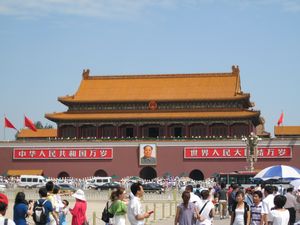Advertisement
Published: June 27th 2011

 Entrance to Forbidden City
Entrance to Forbidden City
This is the famous view that is associated with modern China.After a 12-hour train ride from Hangzhou that we shall never speak of again, the group arrived in Beijing. The first thing that I noticed is that it does not have the same tallness as Shanghai or even Hangzhou. The buildings are still 20 to 30 stories tall but they do not make a distinct skyline. We dragged ourselves to the bus and then to the hotel where we had 2 hours to get back out and start the day’s itinerary.
The first thing to do was to visit Tiananmen Square. To sum up, it’s a big-ass square. There it is also a major site for tourists, domestic and international. We were lucky because we caught it on a slow day. Still, Tiananmen was full of people, along with significant buildings to see. A tall, classic Chinese-style building is in the middle of the square. There is the monument to the liberation war that turned China into a Republic in 1911. There is the Parliament building that sits behind that. They are adding modern structures (like a wall with massive television screens and a half-pipe looking thing). Chairman Mao is in a crystalline sarcophagus in an exhibit on the Southern

 The Forbidden City
The Forbidden City
In the Forbidden City, all of the architecture is similar because it was all built in the same relative time period to facilitate running a country and the emperor's large family.side, but the wait is very long and there are no cameras allowed in and the line is 2-hours long. And of course there is the famous view of Tiananmen, the view of Tiananmen tower with the portrait of Mao.
After viewing Tiananmen, we saw the Forbidden City. This is the place of 700 year’s worth of emperors. It is huge. The regular tour for people with time lasts two and half weeks and we brushed through in an hour and a half. And that is the most direct route through. There are many office buildings and side buildings for relatives and servants. I would not doubt that the Chinese emperor was the wealthiest man in the world at any given time.
After this we went to the Summer Palace. This was a place that was built as the birthday gift for one of the emperor’s mothers. It is a manmade lake that is surrounded by a large house. The Empress Dowager actually made her own contribution by making a marble boat that sits on the lake as if floating. The background story is that this boat was used by the money given to modernize the Chinese Navy

 The Queen's Navy
The Queen's Navy
This is the infamous Empress Dowager's Stone boat. at the end of the 19th century, which was annihilated in a battle with the Japanese. The main reason for the defeat was (here is the punch line that is to be expected unless you actually thought that I was going to lead you on into a random story (this actually does sound like my style so just disregard that)) the result of being technologically inferior.
And that was today. The rest of the day was spent reveling in the glory of rest. So until tomorrow…
Advertisement
Tot: 0.068s; Tpl: 0.01s; cc: 12; qc: 47; dbt: 0.0437s; 1; m:domysql w:travelblog (10.17.0.13); sld: 1;
; mem: 1.1mb

 Entrance to Forbidden City
Entrance to Forbidden City
 The Forbidden City
The Forbidden City
 The Queen's Navy
The Queen's Navy

KW
non-member comment
no pure todavía...?
"...The main reason for the defeat was (here is the punch line that is to be expected unless you actually thought that I was going to lead you on into a random story (this actually does sound like my style so just disregard that)) the result of being technologically inferior." You got it wrong on this, I'am afraid. Qing China's Beiyang Fleet (North Sea Fleet) was still technologically the best navy in East Asia at the time - yes, more advanced than Japan's navy - "strange" right? But true. The fleet was mainly consisted of imported German warships which included some of the most powerful modern warships that Germany has ever made in that period. The fleet outnumbered Japanese navy in both quality and quantity. That battle, a classic testbook exmaple, has been studied extensively in military schools in and ouyside China. The main reasons for that devastating defeat were 1) sheer imcompetence of several key captains in planning and 2) perhaps most impotantly , fierce internal power struggles among them and betrayal in the battlefield. Though otherwise that naval battle could have been won quite easily, it would nonetheless make no difference overall since Qing China as a whole was a half step into her coffin already while Imperial Japan was on the rise...